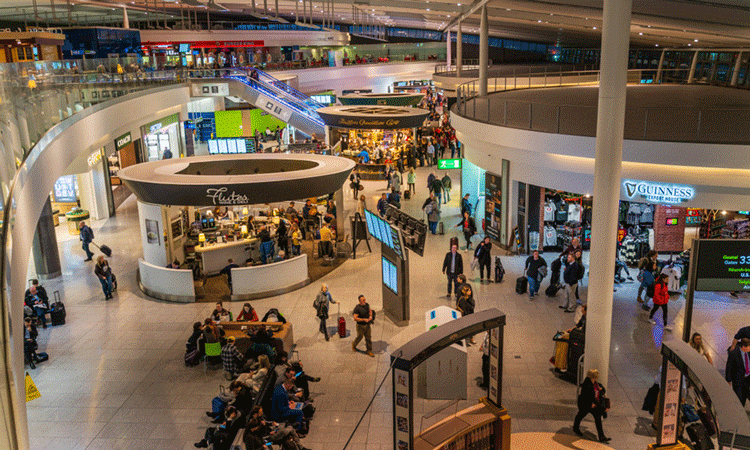How digitalisation is accelerating opportunities with data and analytics
- Like
- Digg
- Del
- Tumblr
- VKontakte
- Buffer
- Love This
- Odnoklassniki
- Meneame
- Blogger
- Amazon
- Yahoo Mail
- Gmail
- AOL
- Newsvine
- HackerNews
- Evernote
- MySpace
- Mail.ru
- Viadeo
- Line
- Comments
- Yummly
- SMS
- Viber
- Telegram
- Subscribe
- Skype
- Facebook Messenger
- Kakao
- LiveJournal
- Yammer
- Edgar
- Fintel
- Mix
- Instapaper
- Copy Link
Posted: 28 August 2019 | Marc Mullan - daa | No comments yet
Utilising data analytics is quickly becoming essential for the successful operation of airport areas including check in, retail, booking and security. But it will also help secure the concept of seamless travel.


Touchpoints such as check in and security within a terminal can provide the greatest levels of stress for passengers. As every airport aspires to create a seamless passenger experience, these pressure points must be resolved.
Marc Mullan, VP – Data & Analytics at daa, detailed how with additional data, and the knowledge of how to use it correctly, delays and frustration can be eliminated from the airport experience.
What role can IoT and geospatial technology play within an airport?
The airport environment is becoming increasingly digitised, including the development of technology that can track every aircraft movement, every bag, device and asset across the airport ecosystem.
IoT creates an incredible opportunity to track and drive business performance across these assets, while the use of geospatial technology – such as GIS platforms – can provide additional context on every location across the campus.
There are many high-value use cases which optimise aircraft movements airfield, the flow of traffic in the campus, seamless movement of passengers through terminals, predictive maintenance of critical assets and real-time measurements of car park occupancy.
How will this affect the way the airports operate?
Data-driven decision making will become the norm across all aspects of airport operation. Airports need to get ready for this data-driven world. New tools will be deployed, new skills required and everyone at all levels of the organisation will need to become more data literate.
This will pose new challenges, particularly with the use of AI becoming more common in key business decisions.
On 26 September 2019, Marc Mullan outlined how Dublin Airport is using data analytics with digital marketing technology to increase personalised engagement with passengers across the full trip lifecycle at the Airport IT & Security conference.
How will this affect passenger experience?
The passenger experience will improve to become a much more seamless experience.
AI models will be developed to deliver more accurate forecasts that are critical for planning the right number of staff required to operate the airport in an efficient manner, which will minimise the frequency of queues for passengers.
Increasingly critical assets such as baggage systems are connected through IoT sensors and monitored to diagnose their health. This real-time asset health capability will be used to proactively manage assets through their full lifecycle. This will help avoid downtime of critical infrastructure and reduce the potential of delays to passengers.
Are passengers reluctant to full disclose their data?
Data privacy is becoming increasingly important, GDPR provides a great framework for all business to make sure all personal passenger data is protected and managed correctly.
Demonstrating that we use passenger data responsibly and for the passengers’ benefit will gain passenger trust. This value exchange between the passenger and the airport is key.
Can you give us an example of how this has been implemented in Dublin Airport?
With over 220,000 flights in a year, and further growth planned, all airfield assets must be managed efficiently. Airfield performance is impacted by several factors such as airport operations, ground handling, air traffic control and knock-on delays caused by issues at other transport hubs.
Dublin Airport has introduced a new EU initiative to improve the flow of air traffic at the airport and reduce flight delays using Airport Collaborative Decision Making (A-CDM). With greater data-sharing it will be possible to review the process end to end and identify points of congestion that lead to delays. Then, action plans can be driven to resolve these.
With these new sources of rich geo-spatial data, the airport is developing models to determine the most important factors impacting on-time performance and how to use these insights to drive action plans for improvements.
Biography
Marc Mullan, VP – Data & Analytics at daa, is a senior leader with over 20 years’ experience successfully developing and delivering strategic change in the fields of data and analytics, multi-channel CRM, sales operations, sales performance management and financial operations. He has worked with large multi nationals across the transport, technology and communications sectors to transform the customer experience, deliver operational efficiency and create value.
Airport IT & Security 2019 brought together CIOs, Directors and Heads of Operations and Security from the world’s major international airports and regional hubs. Make sure you join them next year!
Related topics
Big data, Information technology (IT), Passenger experience and seamless travel, Terminal operations


















